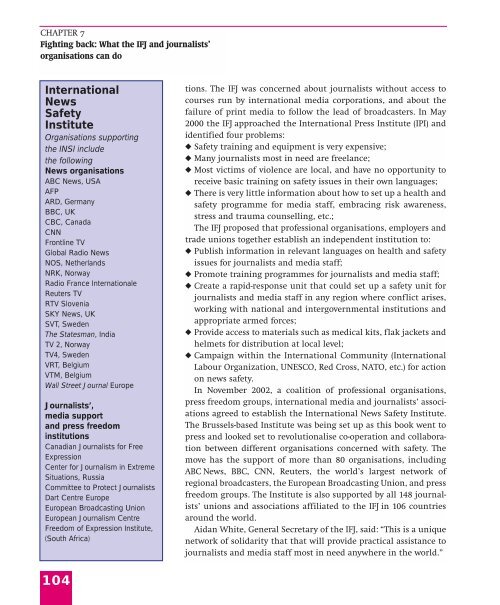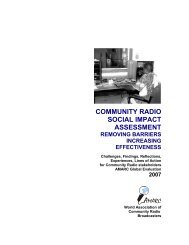Live News - A Survival Guide - International Federation of Journalists
Live News - A Survival Guide - International Federation of Journalists
Live News - A Survival Guide - International Federation of Journalists
- No tags were found...
You also want an ePaper? Increase the reach of your titles
YUMPU automatically turns print PDFs into web optimized ePapers that Google loves.
CHAPTER 7Fighting back: What the IFJ and journalists’organisations can do<strong>International</strong><strong>News</strong>SafetyInstituteOrganisations supportingthe INSI includethe following<strong>News</strong> organisationsABC <strong>News</strong>, USAAFPARD, GermanyBBC, UKCBC, CanadaCNNFrontline TVGlobal Radio <strong>News</strong>NOS, NetherlandsNRK, NorwayRadio France <strong>International</strong>eReuters TVRTV SloveniaSKY <strong>News</strong>, UKSVT, SwedenThe Statesman, IndiaTV 2, NorwayTV4, SwedenVRT, BelgiumVTM, BelgiumWall Street Journal Europe<strong>Journalists</strong>’,media supportand press freedominstitutionsCanadian <strong>Journalists</strong> for FreeExpressionCenter for Journalism in ExtremeSituations, RussiaCommittee to Protect <strong>Journalists</strong>Dart Centre EuropeEuropean Broadcasting UnionEuropean Journalism CentreFreedom <strong>of</strong> Expression Institute,(South Africa)tions. The IFJ was concerned about journalists without access tocourses run by international media corporations, and about thefailure <strong>of</strong> print media to follow the lead <strong>of</strong> broadcasters. In May2000 the IFJ approached the <strong>International</strong> Press Institute (IPI) andidentified four problems:◆ Safety training and equipment is very expensive;◆ Many journalists most in need are freelance;◆ Most victims <strong>of</strong> violence are local, and have no opportunity toreceive basic training on safety issues in their own languages;◆ There is very little information about how to set up a health andsafety programme for media staff, embracing risk awareness,stress and trauma counselling, etc.;The IFJ proposed that pr<strong>of</strong>essional organisations, employers andtrade unions together establish an independent institution to:◆ Publish information in relevant languages on health and safetyissues for journalists and media staff;◆ Promote training programmes for journalists and media staff;◆ Create a rapid-response unit that could set up a safety unit forjournalists and media staff in any region where conflict arises,working with national and intergovernmental institutions andappropriate armed forces;◆ Provide access to materials such as medical kits, flak jackets andhelmets for distribution at local level;◆ Campaign within the <strong>International</strong> Community (<strong>International</strong>Labour Organization, UNESCO, Red Cross, NATO, etc.) for actionon news safety.In November 2002, a coalition <strong>of</strong> pr<strong>of</strong>essional organisations,press freedom groups, international media and journalists’ associationsagreed to establish the <strong>International</strong> <strong>News</strong> Safety Institute.The Brussels-based Institute was being set up as this book went topress and looked set to revolutionalise co-operation and collaborationbetween different organisations concerned with safety. Themove has the support <strong>of</strong> more than 80 organisations, includingABC <strong>News</strong>, BBC, CNN, Reuters, the world’s largest network <strong>of</strong>regional broadcasters, the European Broadcasting Union, and pressfreedom groups. The Institute is also supported by all 148 journalists’unions and associations affiliated to the IFJ in 106 countriesaround the world.Aidan White, General Secretary <strong>of</strong> the IFJ, said: “This is a uniquenetwork <strong>of</strong> solidarity that that will provide practical assistance tojournalists and media staff most in need anywhere in the world.”104
















